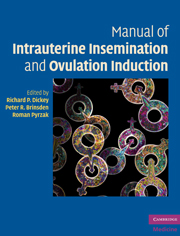Book contents
- Frontmatter
- Contents
- List of contributors
- Preface
- 1 An overview of intrauterine insemination and ovulation induction
- 2 Male causes of infertility: evaluation and treatment
- 3 Female causes of infertility: evaluation and treatment
- 4 Clinic and laboratory design, personnel and equipment
- 5 Semen analysis: semen requirements for intrauterine insemination
- 6 Semen preparation for intrauterine insemination
- 7 Ovulation induction for intrauterine insemination I: oral drugs clomiphene, tamoxifen, letrozole
- 8 Ovulation induction for intrauterine insemination II: gonadotropins and oral drug–gonadotropin combinations
- 9 Ultrasonography in the management of ovulation induction and intrauterine insemination
- 10 Insemination technique and insemination complications
- 11 Cryopreservation
- 12 Donor sperm
- 13 The role of the nurse in intrauterine insemination and ovulation induction
- 14 Complications of ovulation induction I: high-order multiple births, miscarriage, ectopic pregnancy, congenital anomalies, ovarian cancer
- 15 Complications of ovulation induction II: ovarian hyperstimulation syndrome, ovarian torsion
- 16 The psychological issues of intrauterine insemination
- 17 Ethical, legal and religious considerations of artificial insemination
- Index
8 - Ovulation induction for intrauterine insemination II: gonadotropins and oral drug–gonadotropin combinations
Published online by Cambridge University Press: 01 February 2010
- Frontmatter
- Contents
- List of contributors
- Preface
- 1 An overview of intrauterine insemination and ovulation induction
- 2 Male causes of infertility: evaluation and treatment
- 3 Female causes of infertility: evaluation and treatment
- 4 Clinic and laboratory design, personnel and equipment
- 5 Semen analysis: semen requirements for intrauterine insemination
- 6 Semen preparation for intrauterine insemination
- 7 Ovulation induction for intrauterine insemination I: oral drugs clomiphene, tamoxifen, letrozole
- 8 Ovulation induction for intrauterine insemination II: gonadotropins and oral drug–gonadotropin combinations
- 9 Ultrasonography in the management of ovulation induction and intrauterine insemination
- 10 Insemination technique and insemination complications
- 11 Cryopreservation
- 12 Donor sperm
- 13 The role of the nurse in intrauterine insemination and ovulation induction
- 14 Complications of ovulation induction I: high-order multiple births, miscarriage, ectopic pregnancy, congenital anomalies, ovarian cancer
- 15 Complications of ovulation induction II: ovarian hyperstimulation syndrome, ovarian torsion
- 16 The psychological issues of intrauterine insemination
- 17 Ethical, legal and religious considerations of artificial insemination
- Index
Summary
The guiding principle for treatment of women with an-ovulatory infertility should be restoration of the feedback system which selects a single follicle for ovulation … Treatment with gonadotropins should be restricted to women who are resistant to clomiphene.
ESHRE Capri Workshop 2000Introduction
Use of gonadotropins for ovulation induction (OI) in intrauterine insemination (IUI) cycles increases pregnancy rates per cycle compared to IUI alone or with clomiphene (CC-IUI); however, whether pregnancy rates per couple are increased is less certain. Gonadotropin use for OI may be complicated by multiple pregnancies, particularly triplets and higher orders, and by ovarian hyperstimulation syndrome (OHSS). Their use as first-line treatment should be limited to those women who have hypopituitary or hypothalamic amenorrhea not correctable by other treatment. Gonadotropins should not be used in the treatment of “unexplained infertility” for patients who ovulate, but fail to conceive, until a minimum of three cycles of CC with IUI have been tried first. Gonadotropins should not be used in place of CC because of its anti-estrogen effect on endometrial thickness and cervical mucus before first trying tamoxifen (TMX) 40–60 mg for five days instead of CC. These proscriptions will, if followed, significantly reduce the risk of multiple pregnancy and the risk of OHSS.
The risk of multiple pregnancy is related to the number of preovulatory follicles (more with gonadotropins, fewer with CC and TMX), patient's age and initial cycle of treatment.
- Type
- Chapter
- Information
- Publisher: Cambridge University PressPrint publication year: 2009



